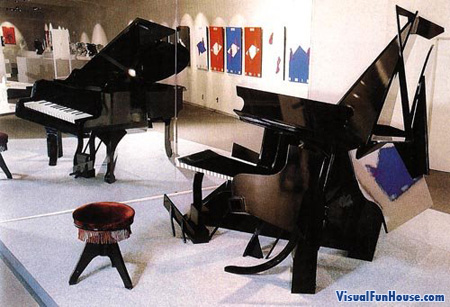Japanese graphic artist and designer, Shigeo Fukuda, enjoyed using visual contradictions, illusions, and abnormal combinations of objects in his works of art, which ranged from posters to complex sculptures.
Fukuda's sense of moral responsibility is shown through his posters, addressing social causes such as pacifism and environmentalism. His most famous poster, Victory 1945, depicts a cannon barrel with its shell pointing downward, back towards the barrel, sealing it forever. The simple design offers a biting criticism of the pointlessness of war.

Victory 1945, offset process, 1975
Though his posters are beautiful, I find Fukuda’s illusionistic art to be more fascinating. His work spans both two-dimensional and three-dimensional mediums including impossible objects, ambiguous sculptures, distorted projections, and anamorphic art.
He once described his philosophy this way: "I believe that in design, 30% dignity, 20% beauty and 50% absurdity are necessary. Rather than catering to the design sensitivity of the general public, there is advancement in design if people are left to feel satisfied with their own superiority, by entrapping them with visual illusion."

Constructed out of 848 forks, knives, and spoons, Lunch with Helmet On appears to be a formless object until a light is shone behind it from a certain angle. Suddenly the impossible shadow of a motorcycle appears out of the chaos.

Lunch with Helmet On, Knives, forks, and spoons, 1987
Similarly, his Duet was a structure which looked like a pianist from one angle and a violinist from another.

Duet
Fukuda also created structures based on M. C. Escher’s lithograph prints, which distorted space and perspective to create “impossible objects” which could not exist in three dimensions. An example of this was his Disappearing Column a three-dimensional rendering of the famous impossible trident.

Disappearing Column, Sculpture in wood, 1985
Taking advantage of an Ames Projection, Fukuda has constructed a bizarre piano so that the lines of it still coincide with the lines of sight of a real piano. Seen from one special angle, the reflection of the physical model looks perfectly normal.

No comments:
Post a Comment